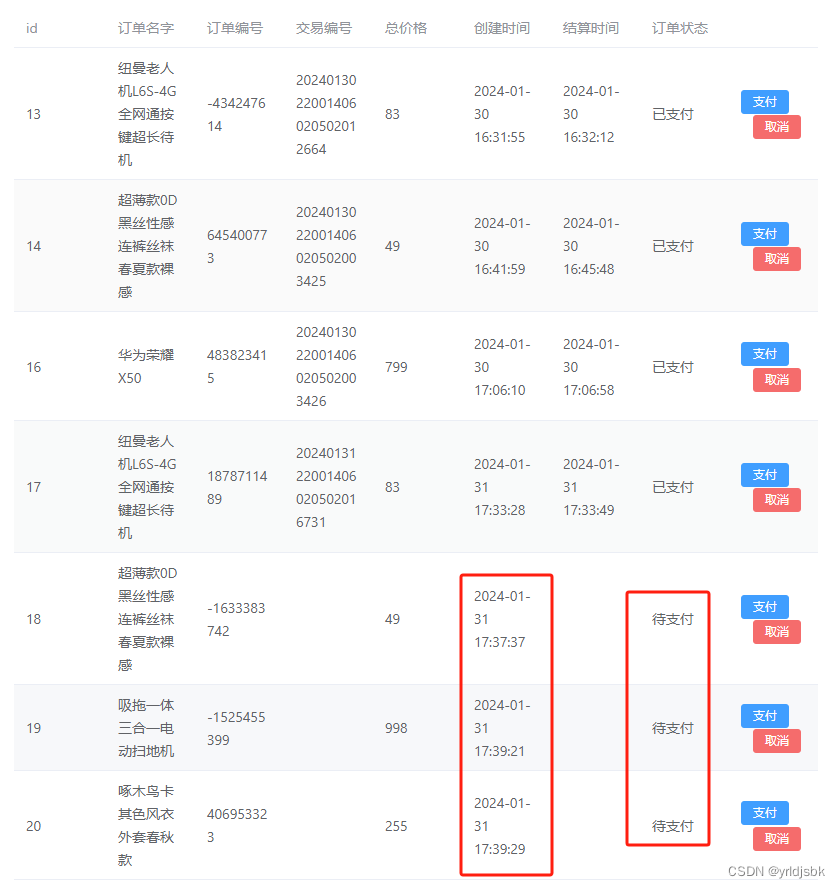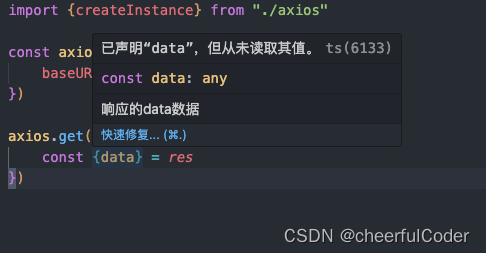axios.create(config)配置一个新的axios
axios 的理解和应用
axios 是什么?
前端最流行的 ajax 的请求库
React/Vue 官方都推荐使用 axios 发 ajax 请求
文档:http://github.com/axios/axios
axios 特点:
使用 axios 发 ajax请求
- axios 调用的返回值是 promise 实例
- 成功的值叫 response ,失败的值叫 error
- axios 成功的值是一个 axios 封装的 response 对象,服务器返回的真正数据在 response.data 中
1. 发送 GET 请求
<body>
<button id="btn">点我获取所有人的信息</button>
<script>
//获取按钮
const btn = document.getElementById('btn');
//获取所有人的信息 发送GET请求 --- 不携带参数
btn.onclick = () => {
//此处写axios代码!
}
</script>
axios get完整版:
const result = axios({
url: 'http://localhost:5000/persons',//请求地址
method: 'GET',//请求方式
});
result.then(
response => {console.log('请求成功了!', response.data);},
error => {console.log('请求失败了,', error);}
);
axios get精简版:
axios.get('http://localhost:5000/persons').then(
response => { console.log('请求成功了!', response.data); },
error => { console.log('请求失败了,', error); }
);
axios get请求发送时携带query参数:
<body>
<button id="btn1">点我获取所有人的信息</button><br><br>
<button id="btn2">点我获取某个人的信息</button>
<input type="text" id="person_id" placeholder="请输入id">
<!--
1. axios 调用的返回值是 promise 实例
2.成功的值叫 response,失败的值叫 error
3.axios成功的值是一个axios封装的response对象,服务器返回的真正数据在response.data中
4.携带query参数时,编写的配置项叫做params
-->
<script>
//获取按钮
const btn1 = document.getElementById('btn1');
const btn2 = document.getElementById('btn2');
const personId = document.getElementById('person_id');
//获取所有人的信息 发送GET请求 --- 不携带参数
btn1.onclick = () => {
...........
}
//获取某个人的信息 发送get请求 --- 携带query参数
btn2.onclick = () => {
//此处写入axios代码
}
</script>
</body>
axios get携带 query参数完整版:
axios({
url:'http://localhost:5000/person',
method:'GET',
params:{id:personId.value}//此处写的params但其实传的是query参数
}).then(
response =>{console.log('成功了',response.data);},
error =>{console.log('失败了',error);}
)
axios get携带 query参数精简版:
axios.get('http://localhost:5000/person',{params:{id:personId.value}},).then(
response =>{console.log('成功了',response.data);},
error =>{console.log('失败了',error);}
)
发送 POST 请求:
<body>
<button id="btn1">点我获取所有人的信息</button><br><br>
<button id="btn2">点我获取某个人的信息</button>
<input type="text" id="person_id" placeholder="请输入id">
<button id="btn3">点我添加一个人</button>
<input type="text" id="person_age" placeholder="请输入age">
<input type="text" id="person_name" placeholder="请输入name"><br><br>
<script>
//获取按钮
const btn1 = document.getElementById('btn1');
const btn2 = document.getElementById('btn2');
const btn4 = document.getElementById('btn4');
const personId = document.getElementById('person_id');
const personAge = document.getElementById('person_age');
const personName = document.getElementById('person_name');
//获取所有人的信息 发送GET请求 --- 不携带参数
btn1.onclick = () => {
...........
}
//获取某个人的信息 发送get请求 --- 携带query参数
btn2.onclick = () => {
...........
}
//添加某个人 发送post请求 --- 携带请求体body参数
btn3.onclick = () =>{
//此处写入axios代码
}
</script>
</body>
axios post完整版:
axios({
url:'http://localhost:5000/person',
method:'POST',
// data:{name:personName.value,age:personAge.value},//携带请求体参数(默认json编码)
data:`name=${personName.value}&age=${personAge.value}`,//携带请求体参数(urlencoded编码)
}).then(
response =>{console.log('成功了'+response.data);},
error =>{console.log('失败了'+error);}
)
axios post精简版:
//使用对象就会默认是json编码模式
//axios.post('http://localhost:5000/person',{name:personName.value,age:personAge.value}).then(
//是用字符串就会默认是urlencoded编码模式
axios.post('http://localhost:5000/person',`name=${personName.value}&age=${personAge.value}`).then(
response =>{console.log('成功了'+response.data);},
error =>{console.log('失败了'+error);}
)
备注:axios 底层源码中也是写入一个判断,假如第二个空中为对象则使用 JSON.stringify 来解码,假如第二个空为模板字符串则使用urlencoded方式来解码。
发送 PUT 请求:
<body>
<button id="btn1">点我获取所有人的信息</button><br><br>
<button id="btn2">点我获取某个人的信息</button>
<input type="text" id="person_id" placeholder="请输入id"><br><br>
<button id="btn3">点我添加一个人</button>
<input type="text" id="person_age" placeholder="请输入age">
<input type="text" id="person_name" placeholder="请输入name"><br><br>
<button id="btn4">点我更新一个人</button>
<input type="text" id="person_update_id" placeholder="请输入一个人的id">
<input type="text" id="person_update_age" placeholder="请输入一个人的年龄">
<input type="text" id="person_update_name" placeholder="请输入一个人的姓名">
<script>
//获取按钮
const btn1 = document.getElementById('btn1');
const btn2 = document.getElementById('btn2');
const btn3 = document.getElementById('btn3');
const btn4 = document.getElementById('btn4');
const personId = document.getElementById('person_id');
const personAge = document.getElementById('person_age');
const personName = document.getElementById('person_name');
const personUpdateId = document.getElementById('person_update_id');
const personUpdateAge = document.getElementById('person_update_age');
const personUpdateName = document.getElementById('person_update_name');
//获取所有人的信息 发送GET请求 --- 不携带参数
btn1.onclick = () => {
........
}
//获取某个人的信息 发送get请求 --- 携带query参数
btn2.onclick = () => {
........
}
//添加某个人 发送post请求 --- 携带请求体body参数
btn3.onclick = () => {
........
}
//更新一个人 发送PUT请求--携带json编码参数 或 urlencoded编码
btn4.onclick = () => {
//此处写入axios代码
}
</script>
</body>
axios put完整版:
//完整版
axios({
url: 'http://localhost:5000/person',
method: 'PUT',
data:{
id:personUpdateId.value,
name:personUpdateName.value,
age:personAge.value
}
}).then(
response => { console.log('成功了' + response.data); },
error => { console.log('失败了' + error); }
)
axios put精简版:
//精简版
axios.put("http://localhost:5000/person",{
id:personUpdateId.value,
name:personUpdateName.value,
age:personAge.value,
}).then(
response => { console.log('成功了' + response.data); },
error => { console.log('失败了' + error); }
)
发送 DELETE 请求:
<body>
<button id="btn1">点我获取所有人的信息</button><br><br>
<button id="btn2">点我获取某个人的信息</button>
<input type="text" id="person_id" placeholder="请输入id"><br><br>
<button id="btn3">点我添加一个人</button>
<input type="text" id="person_age" placeholder="请输入age">
<input type="text" id="person_name" placeholder="请输入name"><br><br>
<button id="btn4">点我更新一个人</button>
<input type="text" id="person_update_id" placeholder="请输入一个人的id">
<input type="text" id="person_update_age" placeholder="请输入一个人的年龄">
<input type="text" id="person_update_name" placeholder="请输入一个人的姓名"><br><br>
<button id="btn5">点我删除一个人</button>
<input type="text" id="person_delete_id" placeholder="请输入一个人的id">
<!--
1. axios 调用的返回值是 promise 实例
2.成功的值叫 response,失败的值叫 error
3.axios成功的值是一个axios封装的response对象,服务器返回的真正数据在response.data中
4.携带query参数时,编写的配置项叫做params
5.携带params参数时,就需要自己手动拼在URL中
-->
<script>
//获取按钮
const btn1 = document.getElementById('btn1');
const btn2 = document.getElementById('btn2');
const btn3 = document.getElementById('btn3');
const btn4 = document.getElementById('btn4');
const btn5 = document.getElementById('btn5');
const personId = document.getElementById('person_id');
const personAge = document.getElementById('person_age');
const personName = document.getElementById('person_name');
const personUpdateId = document.getElementById('person_update_id');
const personUpdateAge = document.getElementById('person_update_age');
const personUpdateName = document.getElementById('person_update_name');
const personDeleteId = document.getElementById('person_delete_id');
//获取所有人的信息 发送GET请求 --- 不携带参数
btn1.onclick = () => {
.........
}
//获取某个人的信息 发送get请求 --- 携带query参数
btn2.onclick = () => {
.........
}
//添加某个人 发送post请求 --- 携带请求体body参数
btn3.onclick = () => {
........
}
//更新一个人 发送PUT请求--携带json编码参数 或 urlencoded编码
btn4.onclick = () => {
.........
}
//删除一个人 发送delete请求---携带params参数
btn5.onclick = () => {
//此处写入axios代码
}
</script>
</body>
axios DELETE 代码:
//使用的params参数的方式
axios({
url:`http://localhost:5000/person/${personDeleteId.value}`,
method:'DELETE',
}).then(
response =>{console.log('成功了',response.data);},
error =>{console.log('失败了',error);}
)
axios 常用配置:
axios({
url:"http://localhost:5000/test1",//请求地址
method:'GET',//请求方式
params:{delay:3000,b:2},//配置query参数
data:{c:3,d:4},//配置请求体参数(json编码)
data:`e=5&f=6`,//配置请求体参数(urlencoded编码)
timeout:2000,//配置超市时间
Headers:{demo:123},//配置请求头
responseType: 'json'//配置响应数据的格式(默认是json)
})
axios 可以全局配置:
//给axios配置默认属性
axios.defaults.timeout= 2000;//配置了默认超时时间
axios.defaults.headers={school:'金科'};//配置每个请求的请求头都自带的内容
axios.defaults.baseURL='http://localhost:5000';
//配置请求的地址,若不配置,则axios默认从自身的地址发送请求;若配置了,写请求时不需要带以上写过的地址,只需要写后面的地址会自动拼接!
axios.create(config)配置一个新的axios
- 根据指定配置创建一个新的 axios ,也就是每个新 axios 都自己的配置
- 新的 axios 只是没有取消请求和批量发请求的方法,其他所有的语法都是一致的,所以不是100%一样
- 为什么要这个语法?
需要:项目中有部分接口需要的配置与另一部分接口需要的配置不一样
<body>
<button id="btn1">点我获取所有人</button>
<button id="btn3">点我获取笑话信息</button>
<script>
const btn1 = document.getElementById('btn1');
const btn3 = document.getElementById('btn3');
//配置axios.create的内容
const axios2 = axios.create({
baseURL:'https//api.apiopen.top',
timeout:3000,
// headers:{name:'王成'}
})
//给axios配置默认属性
axios.defaults.timeout = 2000;
axios.defaults.headers = { school: '金科' };
axios.defaults.baseURL = 'http://localhost:5000';
btn1.onclick = () => {
axios({
..........
}
btn3.onclick = () => {
axios2({
url:'/getJoke',
method:'GET',
}).then(
response =>{console.log('成功了',response.data);},
error =>{console.log('失败了',error);}
)
}
</script>
</body>
备注:axios.create( ) 配置 需要写在 axios 全局配置的前面,否则会报错(目前版本0.27.2)之前某个版本可用
原文地址:https://blog.csdn.net/zqlbanzhuan/article/details/128132133
本文来自互联网用户投稿,该文观点仅代表作者本人,不代表本站立场。本站仅提供信息存储空间服务,不拥有所有权,不承担相关法律责任。
如若转载,请注明出处:http://www.7code.cn/show_31662.html
如若内容造成侵权/违法违规/事实不符,请联系代码007邮箱:suwngjj01@126.com进行投诉反馈,一经查实,立即删除!
主题授权提示:请在后台主题设置-主题授权-激活主题的正版授权,授权购买:RiTheme官网
声明:本站所有文章,如无特殊说明或标注,均为本站原创发布。任何个人或组织,在未征得本站同意时,禁止复制、盗用、采集、发布本站内容到任何网站、书籍等各类媒体平台。如若本站内容侵犯了原著者的合法权益,可联系我们进行处理。








